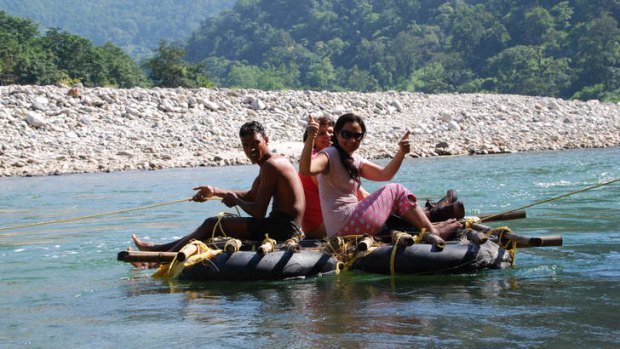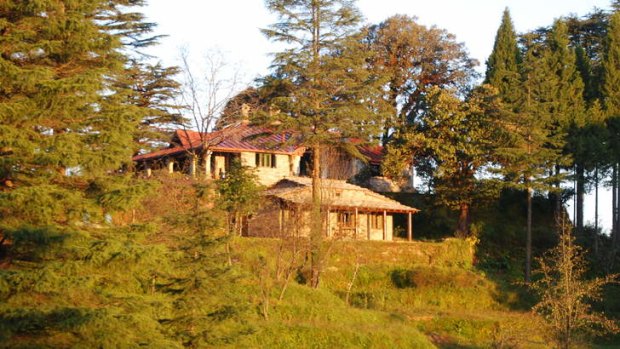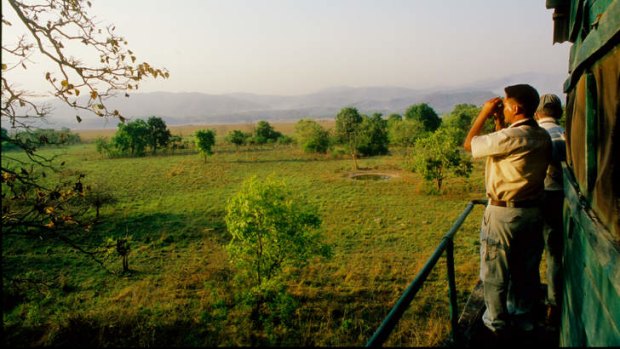By Julie Miller

The makeshift raft.Credit: Julie Miller
Julie Miller has a close encounter with the subcontinental concept of jugaad.
There's a saying in India that's come to represent the subcontinent's mind-boggling economic reinvention - "jugaad". It means "creative ingenuity", or an "innovative fix", and it's what Indians do best. Thirty-five people in an auto-rickshaw? Jugaad. A truck built from a bullock cart and water pump engine? Jugaad. In India there is always a solution, whatever the challenge.
So, when faced with the prospect of being stranded deep in the wilds of India, I'm told, "Do not worry, madam. We will think of something". I then watch, fascinated, as jugaad comes into play ...

Nandadevi Estate.Credit: Julie Miller
Two days earlier, our small tour group - experiencing a custom-designed Mantra Wild Adventures Himalaya Elements itinerary - commenced an easy two-kilometre trek to Vanghat, a privately owned retreat on the border of the Jim Corbett National Park in the northern state of Uttarakhand, to enjoy several days' relaxation in a remote, pristine environment.
This is what Mantra Wild's experiences are all about - immersion in the cultural and natural heritage of India, interacting with local communities and going off the beaten track. But this path is not only remote - it's also closed. Halfway to our destination, we are stopped by authorities and informed we cannot proceed due to a temporary Supreme Court ban on tourism in core tiger habitats. We are forced to retrace our steps - luggage and all - to the lodge via the only other route, a five-kilometre goat track in dense jungle, up perilous cliffs and along a terrifying precipice.
We make it - just - but the prospect of returning along the same dangerous and exhausting route fills us with dread.

Jim Corbett National Park.
The staff at the lodge set about creating an alternative means of transport: a raft made from bamboo and inner tubes. This makeshift vessel will carry four women and their luggage across the swollen Ramganga River, where our transport will be waiting just a short walk away.
We can now relax and enjoy what Vanghat has to offer - absolute peace and quiet. Built of all-natural local materials, this simple wilderness retreat consisting of five individual huts and an open dining sala is ours exclusively for two days.
The days are as lazy or active as we desire. We walk, take photos, swim in the river and practise yoga. We grab binoculars to study colourful birds and cheeky langurs frolicking on the cliff opposite. We eat delicious curries made from freshly picked ingredients.
In the evenings we gather around a bonfire, gazing at the night sky ablaze with shooting stars and listening to a sambar deer sounding a warning.
In the Indian jungle, that means one thing: tiger. When the sambar (or perhaps a barking deer) voices an alarm, other animals take note: a big cat is close by. The following morning, during a sunrise hike along the rocky beach, we find the evidence - huge paw prints of an adult tiger on the way to the river.
The tracks are less than 50 metres from our lodge and, though we never saw it, I'm excited beyond belief to know that there was, indeed, one so close.
Jim Corbett National Park is India's premier tiger habitat, with a known population of more than 200 endangered Bengals. But unlike other national parks such as Ranthambore in Rajasthan, dense foliage makes tiger sightings here extremely rare.
The national park - India's oldest, established in 1936 - is named after author and tiger conservationist Jim Corbett. Famed as a hot-shot hunter of man-eating tigers and leopards in the early 1900s, Corbett reputedly turned from tiger tracker to tiger champion after staring one in the eye and recognising its majesty. He then vowed never to kill another cat unless it was posing a threat to man, focusing instead on hunting with a camera lens. He also made it his mission to preserve jungle habitat so tigers would have a safe haven, and therefore not infringe on human settlement.
A similar problem has led to the four-month national park ban that caused our stranding - finding a solution to the human/tiger impasse. Though this injunction was lifted several days after our visit, the impact of tourism on tiger populations is an ongoing and controversial debate, with some experts arguing that the only way tiger numbers can recover is to keep core areas free of human activity.
Other researchers, however - including Vanghat's owner, ecologist Sumantha Ghosh - believe the key to managing wilderness regions is to involve local communities in tourism ventures; this would provide employment, thereby creating a culture where poaching - by far the biggest threat to tiger populations - is no option. Implementing such innovations, however, is a slow process, particular in an industry whose focus is on making money rather than sustainability.
Meanwhile, alongside the Ramganga River, the highly anticipated raft has been completed and tested; we climb aboard tentatively, fast-flowing waters lapping through gaps in the bamboo. The vessel is then pulled cross-river by a pulley system, ropes firmly tethered to prevent us being swept through the rapids.
We arrive high and dry, with back-slapping and congratulations all round. Talk is that the raft will stay in service for future guests seeking an adventurous alternative to Vanghat's usual entrance by foot or jeep - a fine example of Indian "jugaad" indeed!
Several hours and another hairy journey later we arrive at Nandadevi Estate, a wilderness retreat in the heart of Binsar Wildlife Sanctuary. This beautiful patch of jungle 25 kilometres north of Almora perches at an average altitude of 2412 metres, its lush subalpine vegetation hiding a plethora of fauna including leopards, black bears, langurs, barking deer and porcupines.
Within the sanctuary are several grand estates, established by the real-estate-savvy British between 1805 and 1947. Nandadevi was the jewel in the colonial crown, located on a glorious ridge at 2286 metres with commanding 180-degree views of the Indian Himalayas. The residence of a succession of district magistrates, the mansion passed into the hands of an Indian wine merchant when the British departed, payment for an overdue alcohol bill. In 1956, it was sold to Indian philosopher Vivek Datta and his Belgian musicologist wife, who lived here - along with the original furniture shipped from England - for more than 50 years.
The estate belongs to their daughter, Mukti, who single-handedly fought to have surrounding jungle declared a sanctuary in 1989, set up Panchachuli Women Weavers (the largest employer of rural women in Uttarakhand), and has opened her magnificent home to a restricted number of guests.
We are staying in what once was the estate barn, converted into the cosy Writer's Cottage (named after an Italian author who spent five years writing a book there). There is no running hot water and generator power is limited, but it is incredibly comfortable, with three bedrooms decorated with antiques, a spacious lounge, enticing writing nook and kitchen manned with two staff who whip up meals from home-grown organic produce and deliver buckets of steaming water to our en suites.
During our brief stay we are content to just sit and stare at the snow-capped peaks. More than 500 kilometres of mountains are on display, with the highest, Nanda Devi - named for the Hindu goddess of bliss - perfectly framed between ancient deodar cedars.
The following morning we breakfast at the main house, where the views are even more spectacular, and listen, fascinated, as Mukti describes her upbringing on this remote estate.
She attended Oxford University but her real education, she says, was here at Nandadevi. Gazing out at the tiara of glistening peaks framed through the mansion windows, I can fully appreciate why the preservation of this incredible legacy means so much to her. It's mesmerising; I, too, never want to leave.
The writer travelled as a guest of Indian Tourism and Mantra Wild Adventures.
TRIP NOTES
MORE INFORMATION
India Tourism, incredibleindia.org
GETTING THERE
Singapore Airlines has a fare to New Delhi for about $1220 low-season return from Sydney and Melbourne including taxes. Fly to Singapore (about 8hr) and then to New Delhi (5hr 45min); Phone 13 10 11; see singaporeair.com.
TOURING THERE
A 10-day Mantra Wild Adventures Himalaya Elements tour, including visits to Corbett National Park, Vanghat Lodge and Nandadevi Estate, costs from $3999 a person. Custom wilderness and wellness tours are also available. Phone 9555 2997; see mantrawild.com.au.
Sign up for the Traveller Deals newsletter
Get exclusive travel deals delivered straight to your inbox. Sign up now.